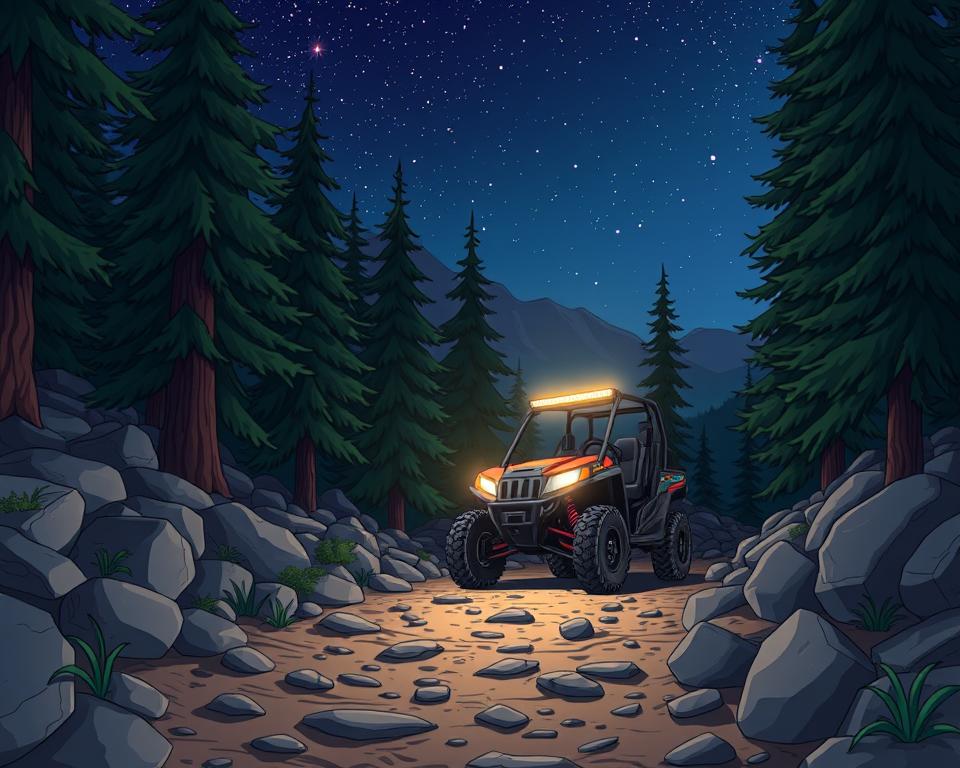Avoiding ATV/UTV Gearing Mistakes for Newbies
Did you realize that nearly 25% of new ATV and UTV owners face gear selection issues within their first year? This statistic underlines the importance of grasping ATV gear ratios for beginners. Correct gear choice protects against accidents as well as enhances power. We’ll explore common mistakes, maintenance practices, and expert warner winches advice to improve your off-road adventures.
Critical Findings

- Understanding gear ratios is vital for optimal ATV/UTV performance.
- Common gearing oversights can lead to safety risks on the trails.
- Regular maintenance is key to preventing UTV transmission issues.
- Smart gear choices transform your outdoor rides.
- Applying service recommendations increases longevity.
Understanding ATV and UTV Gear Ratios
Ratios determine how engine output translates to drive force. They shape acceleration and pulling strength. This affects acceleration and the vehicle’s ability to pull loads. Custom gearing shifts focus from speed to torque or vice versa.
Choosing the right UTV gear is key to understanding engine performance. Excessively low gearing reduces hill-climbing pull. Overgearing sacrifices quickness for top-end speed.
Riders often tweak reduction ratios for trail versatility. Ratio mods shape how your rig behaves off-road. This ensures the machine operates efficiently, whether prioritizing speed or torque. Finding the sweet spot in gearing enhances ride quality and fuel economy.
Common Gearing Oversights for New ATV/UTV Owners
Correct gearing secures top output and trail safety. First-timers frequently ignore ratio considerations. Understanding the effects of wrong gear choices and selecting the right one for your terrain can greatly improve your ride. And it sidesteps needless breakdowns.
Impact of Incorrect Gear Selection
Wrong ratios threaten stability and component life. Incorrect ratios reduce pulling power, hamper braking, and grind parts. These mistakes can significantly reduce riding safety, posing risks to the rider, passengers, and others nearby. Following key ATV maintenance tips can help avoid these issues.
Choosing the Right Gear for Terrain
Each surface demands its own ratio. For steep hills, lower gears provide better torque and control. On flat terrains, higher gears help increase speed. Mucky surfaces require cautious gearing to maintain momentum. Recognizing terrain traits delivers safer, smoother rides.
The Importance of Proper ATV Maintenance
Scheduled service avoids surprises on the trail. Following ATV maintenance tips helps avoid unexpected breakdowns and boosts safety. A tailored service plan prioritizes drivetrain care.
Regular Inspection and Maintenance
A detailed inspection checklist is essential for spotting issues early. It’s important to check gears, brakes, tires, and belts regularly. Integrating inspections into your schedule boosts reliability. Here are some critical inspection points to remember:
- Inspect gearbox alignment and pitting.
- Verify hardware and linkages are secure.
- Assess brake fluid and hydraulic systems.
- Measure wheel pressure and wear.
- Check wiring and connectors for rust.
Fluid Changes and Gear Health
Fresh oils ensure the gearbox stays healthy. Routine fluid swaps avoid sludge and varnish. Pure coolant and oil lower temperatures and prolong service intervals. Using this method secures dependable function and fewer breakdowns.
| Fluid Type | Recommended Change Interval | Benefits of Regular Change |
|---|---|---|
| Motor Oil | 50–100 operating hours | Reduces engine wear, enhances performance |
| Gear Oil | 100–200 operating hours | Smooths shifts and prevents pitting |
| Coolant | Once per year | Stops boil-overs and freezes |
Adhering to this schedule grants worry-free adventures. It turns rides into stress-free experiences.
Common ATV Gear Shifting Problems
Many beginners wrestle with the gearbox. Learning silky shift methods transforms your ride. This stops shift-related aggravation. Synchronizing engine speed and clutch engagement stops misshifts.
Learning to Shift Smoothly
Honing silky shift skills takes deliberate training. Begin by listening to your motor’s cadence. Careful engagement protects internals and stops wear. Timing your throttle input when releasing the clutch is critical.
Practice shifting in a controlled setting until you’re confident. Keep your throttle light when shifting.
Recognizing Signs of Gear Issues
Catching faults early saves time and money. Listen for unusual sounds like grinding or popping, which may mean gears aren’t engaging right. Difficulty shifting can also signal problems that need quick attention. Spotting these signs early can prevent major damage and ensure a safer ride. Resolving shift issues preserves power delivery and morale.
Understanding UTV Transmission Issues
Dealing with UTV transmission problems can be tough, but knowing the common issues is vital for troubleshooting. Owners often face issues like slipping gears or odd noises. Below we break down common failures and the tools to troubleshoot them. It’s based on a practical UTV troubleshooting guide.
Diagnosing Common Problems
Recognizing the signs of transmission troubles is essential. Common issues include:
- Unexpected gear drops that compromise handling.
- Unusual sounds, such as grinding or whining, indicating mechanical damage.
- Drips or puddles under the UTV may foretell failures.
Regular gear diagnostics help spot these issues quickly. You can then address issues swiftly. Missing early clues damages your ride and wallet.
Solutions for Troubleshooting UTV Transmissions
Solving drivetrain faults depends on a structured routine. Follow these steps for effective troubleshooting:
- Check fluid levels and top up if necessary.
- Look for wet spots beneath the transmission.
- Assess internal components for wear or chipping.
- Test drive the UTV at various speeds to monitor gear engagement and responsiveness.
- Reference factory troubleshooting charts for your UTV.
Using a reliable UTV troubleshooting guide can streamline the process. Grasping drivetrain theory helps maintain your rig. That insight preserves reliability and output.
ATV Clutch Adjustments and Their Benefits
Accurate clutch tuning unlocks seamless shifts. Incorrect adjustments can make shifting gears tough, frustrating for beginners. Regular adjustments improve clutch performance, leading to better gear shifting.
Adjusting gears with precision is vital. A well-set clutch delivers fast, clean shifts. It refines acceleration and comfort across all conditions.
Skipping clutch care leads to early failures and poor shifts. Proper maintenance leads to smoother shifts and better engine response. Every operator should prioritize clutch checks for optimal use.
Mastering the Art of Gear Shifting
Becoming adept at shifts transforms your off-road sessions. Understanding drivetrain function and shift timing is crucial. Rookies need to practice gear timing. A comfortable cadence leads to smoother transitions and improved performance.
Proficient gear shifting demands practice, across various riding conditions. Recognizing terrain-specific shift cues boosts confidence and protection. Dropping a gear before a climb preserves torque and control.
- Drill slow shifts to master the clutch.
- Observe how your vehicle responds to different shifts.
- Advance to tougher conditions to refine technique.
Getting in sync with your ride ensures perfect shifts. Heed revs and shakes to know shift points. Such feedback tells you when to execute transitions. Such intuitive understanding leads to proficient gear shifting, making your ride more enjoyable.
Best Practices for UTV Gear Selector Problems
Tackling selector issues calls for scheduled checks and troubleshooting. Frequent selector checks prevent surprises. By mastering gear selection techniques, operators can avoid malfunctions. Routine checks should include visual inspections of the selector linkage and fluid levels, which are vital for performance.
At the first sign of trouble, clear debris from the shifter. Clunks or rattles can signal a loose linkage. A quick tighten or lube can restore function. An organized maintenance schedule helps manage wear and tear.
Tracking shift quality across terrains isolates faults. Applying these tips secures selector durability and trail confidence.
Tips for Enhancing Gear Performance
Achieving top drivetrain function demands regular attention. Regular maintenance is key to improving ATV efficiency. Verify oil levels, examine parts, and tweak calibrations. Catching nicks before they worsen saves you big bucks.
Choosing the right gear ratios is essential for maximizing engine response and achieving a smoother ride. Assessing ground conditions guides your ratio picks. It shapes your bike’s quickness and runway performance. Partnering with trusted makers like American Off-Roads for UTV performance enhancements adds power and reliability.
Utilizing gear performance tips focused on tire selection, suspension adjustments, and weight distribution can further improve overall gear efficiency. Making these adjustments ensures that both ATVs and UTVs handle better in challenging environments. Your rides become more fun and less fatiguing. By using these methods, you’ll tackle trails boldly and relish every moment.
As a Final Point
Getting your gears right is the key to speed and security. Matching gears to ground types transforms your adventure. Steering clear of rookie errors and picking wisely ensures safe, thrilling rides.
You can’t overemphasize regular service for power health. Routine inspections and care fend off failures and boost lifespan. Proper care boosts efficiency and keeps you safe in diverse environments.
Merging smart ratio choice and regular upkeep yields the best off-road enjoyment. Adopting these practices ensures many memorable rides and adventures in the future.
FAQ
Standard gear ratios on off-road rigs?
Gear ratios span a broad spectrum across makes and models. Typical ratios lie within the 3-to-5 range. Smaller ratios deliver grunt for trails and climbs. Taller ratios boost runway speed on level ground.
Signs of misgearing for different surfaces?
Misgearing risks unstable handling, rev overload, or sluggish starts. Each terrain type—mud, sand, rock, or snow—requires specific gear selection for optimal performance.
Warning signs for upkeep on your off-road vehicle?
Look out for signs like difficulty shifting gears, unusual noises from the transmission, fluid leaks, or a decrease in performance. Scheduling drivetrain inspections stops big failures.
When to swap your drivetrain oils?
Aim for a fluid swap between 1,500–2,500 miles or annually, whichever comes first. Pure oils maintain smooth shifts and protect internals over time.
Best practices for flawless shifts?
Master the throttle-clutch dance for silky shifts. Gradually release the clutch while pressing the throttle to match engine speed with wheel speed.
Steps to diagnose gearbox problems?
First, inspect oil, then note any unusual gearbox sounds. Verify oil clarity and fill. Then, perform a basic diagnostic to identify any mechanical failures.
Benefits of tuning your clutch?
Proper clutch adjustments are essential for smooth gear transitions. Bad clutch alignment wears out parts prematurely and hinders shifts.
Optimizing gears for varied ground?
Test multiple gearing options and look into quality mods by American Off-Roads. Regular maintenance, such as checking gear health and fluid levels, also enhances performance.
What should I do if my UTV gear selector is malfunctioning?
Scheduled upkeep resolves most shifter faults. When the shifter binds, use the OEM troubleshooting procedures to find the root cause.
What common mistakes should new ATV/UTV owners avoid?
Rookies tend to ignore ratio basics, delay upkeep, or misgear for mud, rock, or hills. Such errors cause subpar power delivery and increased accident risk.


